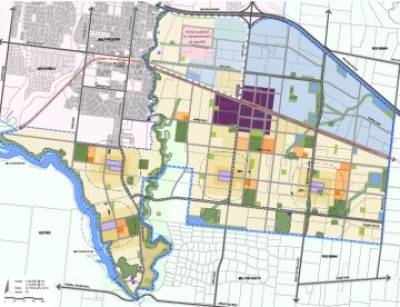home » news » urban planning » Australia
The cars that ate the city

“So many people. Where are they coming from… where are they going”
Bela Lugosi introducing the awful movie “Glen or Glenda?” (1950s) while the camera zooms in on a new-fangled freeway.
The city is an organism. Cars are its lifeblood. Or so they’d have you believe.
Vehicles and roads lubricate trade within a city. They allow people to meet to perform business. They allow people who live at “A” to drop the kids off at “B” and get to work at “C”, all within a reasonable time. They enable citizens to interact with the city. But they are also killing off the quality of life in the city.
This is a minority point of view. Both major political parties view cars as an extension of the voter’s body. Petrol tax cuts and pricey freeways through native bushlands are recent pledges of both major Australian parties. The media has not been critical. We are addicted to cars and view them as indispensible, if expensive. As a Dilbert cartoon recently illustrated: we sit in traffic waiting to get to work so that we can pay the repair bills on the car.
Cars occupy a privileged place in the built environment. Take the heritage streetscape. The heritage facade is a sacred beast in most newish cities and councils carefully outline how you can proceed with renovations and maintain the consistency of the street frontage. This usually means not allowing your renovation to be visible from the street, and installing the correct picket fence. But if you walk out onto a “heritage” street to fully appreciate the splendour of this frontage (while watching for cars), your view is blocked by a motley line of vehicles, none obeying heritage colour requirements. This somewhat disturbs the intended illusion. No one seems to pick up on this – cars are indispensable and shiftable thus rendered invisible.
Secondary roads can be seen as expensive dormitories for cars. Zoom out a bit and look down on the city: 30% (44% in L.A.) is roads and carparks. Is it justifiable? Imagine the value of that land. Why should the road network be over-efficient and over-resourced compared to any other kind of public infrastructure?
Acres of grey asphalt bake quietly in the sun until the working day ends and the working population drives slowly home in the “rush hour”. This is partly the fault of the traditional 9-5 working day. It is also partly due to people’s ability to work a great distance from where they live (because of cars).
If this writer was a benign despot and issued a decree that only essential private cars could use roads, what might happen? Apart from a revolution.
- People’s worlds would decrease in size- they would have to live and work within a smaller, manageable area.
- People might as a result find it harder to find work – or the nature of work would change.
- ‘Suburbs’ would become denser and contain a better land usage mix.
- Public transportation would grow and improve to cater for the increase in passengers.
- Regional towns would become an attractive alternative for those seeking a big backyard.
- Pedestrians would be thrilled to be able to cross roads safely.

Car culture contributes to air pollution – which leads to respiratory diseases and skin cancer (not to mention the end of the world). It contributes to noise pollution, trade deficits, injury and death, litter, the severing of urban communities, unsustainable outer-suburban sprawl, and an unhealthy and overweight population. We need to reduce it to regain a reasonable living environment. How? Get out of the car.
“Things all got too much for author Kudno Mojesic. He was arrested in the street outside his Belgrade home attacking cars with an axe, yelling ‘Away with all cars, they are the devil’s work!’ “ SUNDAY MIRROR, LONDON: 11TH JANUARY 1976.
Peter Johns
reformed driver
READING
car free cities – a blueprint for a city without cars.
bike people – cars, bikes, roads, cities.
This article was originally posted at zebralinks.tripod.com in 2001 and was transferred to butterpaper.com in 2002. In 2014 it was moved from a static html page to the content management system.
Posted by Peter on 20.11.01 in urban planning
comment
Commenting is closed for this article.




